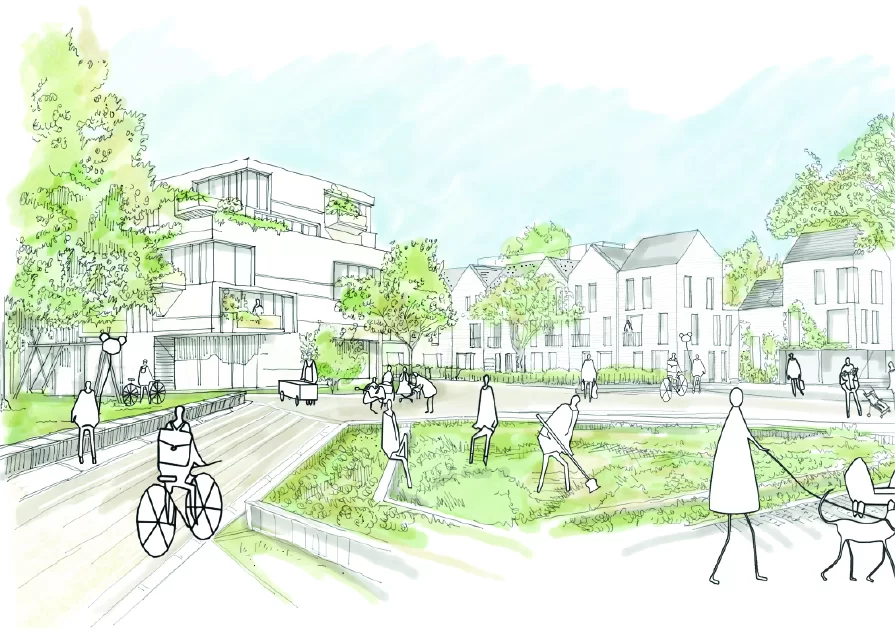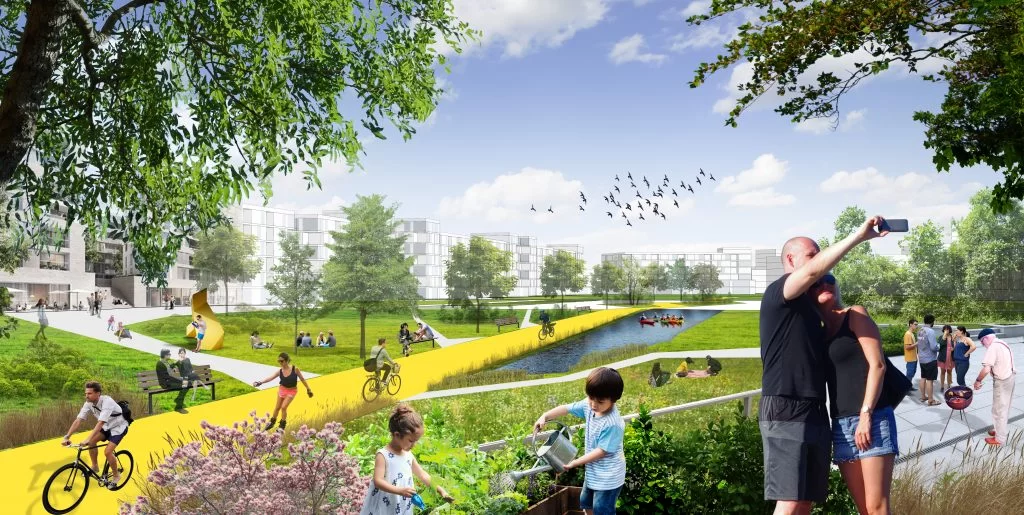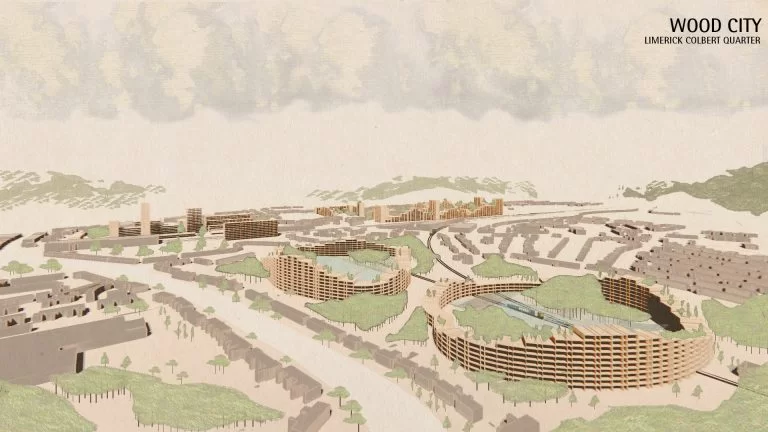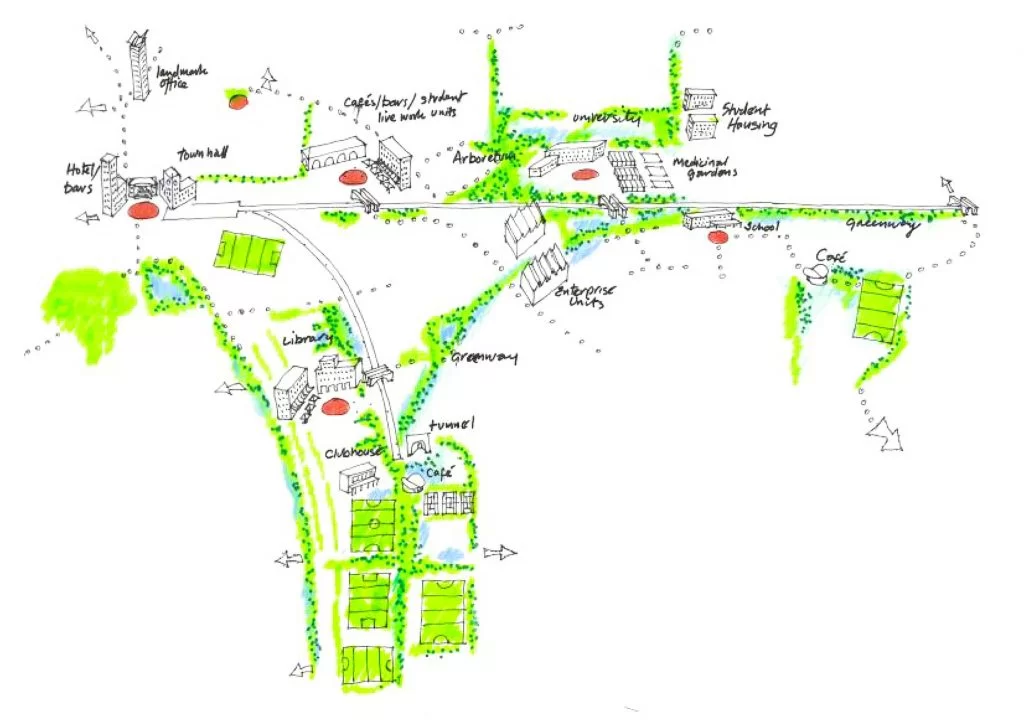Colbert Station Quarter Update
Launch of Public Consultation on RIAI Design Review Limerick Colbert: The LDA and Limerick City and County Council are seeking the views of local stakeholders on the Draft Design Review Report visions and ideas for the Colbert Station Quarter of Limerick.
This phase of consultation will run from 23rd September to October 23rd and views can be submitted via email [email protected]
The LDA will host a Limerick Colbert Station Quarter Design Review webinar on 30th September 5.30pm (Webinar link ), to outline the aims and ambitious ideas that have arisen from the design review process and to answer questions that the public and local interests may have. The webinar will include presentations on the concepts put forward. Please sign up at the Weblink address provided.
Topic: LDA – Design Review Colbert Station Webinar
Time: Sep 30, 2020 05:30 PM
REGISTER HERE
Colbert Station Quarter Update
- Transformational Ideas for new mixed-use city quarter presented to Limerick Council
- Transport hub at the centre of unlocking sustainable polycentric development
- Extensive community consultation process to continue
- State agencies come together to drive regeneration and affordable housing development
Limerick has moved one step closer to unlocking the transformational potential of a new vibrant and highly connected mixed-use city quarter in the area surrounding Colbert Station.
Unlocking the potential of underutilised lands here will enable Colbert Station Quarter to develop and become a highly sustainable and attractive destination for business and community to thrive, providing high quality office and commercial space and offering an enhanced city living experience for potentially six to ten thousand people in a prime city centre location.
The Land Development Agency (LDA) working with Limerick City and County Council, commissioned the RIAI, to undertake a Design Review for the Colbert Station area of Limerick, to identify high level design ideas and concepts that could be considered for the future development of a new urban quarter. The Design Review ideas were presented to metropolitan members of Limerick City and County Council today. The transformational visions and concepts from five leading architects and urban designers will now be the subject of a public consultation process over the coming month. The Design Review provides a framework to build consensus about a single vision for the lands.
These five visions and the feedback from stakeholders will inform the next stage of the project, the creation of a Spatial Framework for Limerick Colbert Station Quarter. At this point there will be detailed engagement regarding the objectives and key opportunity sites, and this will give shape to the vision and types of development which could take place in the quarter. It is intended that this Spatial Framework will help to inform key objectives for the future development of the area, including feeding into the Limerick City and County Development Plan for 2022 -28 which is currently being developed. This Plan will provide the statutory basis for the future planning and development of Limerick City and County. The development of a final project and associated planning applications will follow to unlock and rejuvenate key parts of this new Gateway for Limerick into a highly connected and vibrant mixed-use new city quarter. Plans for near term development opportunities will be progressed in parallel during 2021.
Members of the public can access the Design Review documents on the Land Development Agency website, www.lda.ie. A copy of the document will also be available in Limerick City and County Council office Merchants Quay, Limerick. The LDA and Limerick City and County Council are seeking the views of local stakeholders on the Design Review options. This phase of consultation will run from Wednesday 23rd September to Wednesday October 21st. Views from the community and stakeholders on the Design Review visions are invited and can be provided via email to [email protected].
The LDA will host a webinar on 30th September 5.30pm (weblink will be available on www.lda.ie), to outline the aims and ambitious ideas that have arisen from the design review and to answer questions that the public and local interests may have. The webinar will include presentations on the concepts put forward. Details of the webinar will be available on the LDA website.
The Colbert Station Quarter includes significant areas of state lands owned by the Council, CIE, the HSE, as well as other publicly owned lands. These state organisations have come together to support and explore the future potential for this pivotal area, and to consider how underutilised parts of the lands could be rejuvenated to support and promote Limerick’s ongoing growth and prosperity into the future. The potential development area covers over 50 hectares (a football pitch is approximately 0.8 hectares) and already incorporates a key public transport hub as well as a range of educational, health, community, and recreational uses. It has the potential to become a new 21st Century gateway for Limerick – the first vision of the once walled medieval city for all arriving to the city on public transport.
A public consultation prior to the Design Review received an excellent response from local community and stakeholders, keen to engage from the outset of the project. Almost all suggestions reinforced the importance of strong community and integrating the new community with existing communities. There was an emphasis on providing a mix of accommodation for people of all ages, incomes, and all walks of life. Submissions called for inclusion of retail and premium office space to encourage job creation. Additional facilities for the local community were seen as key, as well as facilities to encourage arts, culture and sporting activity. This feedback was incorporated into the designs by leading architects who presented a series of ambitious visions and concepts, in the Design Review report presented to Councillors on Wednesday.
The Design Review process was managed by the RIAI, and Chaired by David Browne, (a practicing Architect, and former President of the Royal Institute of Architects of Ireland). The purpose of a Design Review is to introduce architectural expertise early in an urban development process by working with architectural consultancies. Five leading architects and urban designers have provided different visions for how Colbert Street could evolve as part of a re-development process. These visions and ideas will form a basis for public consultation which is being launched on 23rd September.
Chairman of the LDA and Limerick city resident, John Moran
“Today is another very important day for the development of our city. These strategically important lands offer potential for the same transformative change as when the city expanded into nearby Newtown Pery. This new development can both serve existing and new communities, creating significant new housing delivery and acting as a magnet for new public and private investment.
The LDA is mandated to co-ordinate state lands, to optimise their potential and increase the supply of housing where most needed. Our partnership with the Local Authority and various state agencies, working together to redesign the future is a model for what we are seeking to achieve across the country.
The Design Review process has confirmed our belief that Colbert Station and the surrounding lands fit neatly into our vision for a polycentric development of Limerick to accommodate very significant population growth. This is the way to minimise the risk of the city centre or other overdeveloped areas becoming unaffordable to all who want to live or work there and to keep commuting times down and develop walkable 15 minute neighbourhoods all across the city footprint.
The designs of the architects, to whom we are very grateful for their work, show the pathway to transform underutilised brownfield areas into such vibrant, affordable compact, mixed–use urban quarters.”
Design Review Champion, David Browne explained the process.
“The Design Review of the Colbert Station Quarter has been a great opportunity to explore the creation of a new city quarter which can be an inspirational model for urban regeneration in Limerick and other Irish cities. The vision for this Design Review has been to create a new sustainable vibrant, liveable city quarter, building on the strengths of the existing area. When realised this quarter could play a central role in the future growth of Limerick city, benefiting all communities.”
Kathryn Meghen, RIAI Chief Executive
“The RIAI was delighted to be asked to lead this Design Review process. The Design Review introduces architectural expertise and innovation from the start of the project. Based on the initial consultations with community, five leading architects and urban designers have applied their skills to create an initial vision for an exciting development for the City and its people.
“All of the architects believe that Colbert Station Quarter can be an exemplary urban development, with a strong emphasis on affordable houses, built in attractive urban spaces, with leisure, education and employment opportunities in close proximity. All of the designs incorporate sustainability at their core. We look forward to the feedback from local stakeholders on the creative visions which have been put forward by this talented group of architects.”
Pat Daly, Chief Executive Limerick City and County Council
“Working with the Land Development Agency and other stakeholders, this collaborative design review project offers an exciting opportunity to collectively reimagine and reinvent the Colbert Station Quarter. This has the potential to unlock a key city centre site that could result in the development of landmark projects that will compliment established city activity. This will be a transformational and integrated project, drawing together a wide mix of land uses and activities, that will promote innovation, collaboration and sustainable design.”
The architects and urban designers whose work is included in the review are Grafton Architects, Sean O’Laoire and Mola Architects, Anne Kiernan, Merritt Bucholz and Piotr Mach. Biographies of the participating architects are included in the design booklet.
The Design Review Report and further background information will be available at www.lda.ie
The Land Development Agency (LDA) was created in September 2018 with the purpose of opening up state owned land for development. The Government has committed to capitalising it with €1.25 billion following enactment of its grounding legislation. The LDA has a national focus and is currently active on sites that will deliver around 4,000 homes.
Limerick City and County Council (LCCC) Limerick City and County Council (Comhairle Cathrach agus Contae Luimnigh) is the authority responsible for local government in the City of Limerick and County Limerick in Ireland. The city and county administration is headed by Chief Executive, Dr. Pat Daly.
Through its delivery vehicle, Limerick Twenty Thirty, LCCC recently completed works on Limerick’s newest high-grade office space development, the award-winning and LEED Gold standard Gardens International. Limerick Twenty Thirty has also submitted planning permission for the 1.62 hectare Opera Site, which will have the capacity to accommodate up to 3,000 workers. The total cost of that project is expected to be €180 million, with 94% of the cost secured through European Investment Bank and the Council of Europe Development Bank loans.
Limerick City is the main economic driver of the Mid-West of Ireland. According to the Limerick Economic Monitor, Limerick City and County has recently undergone five years of economic growth delivering more than 15,000 jobs, unemployment decreased by 14.2 percentage points over the past six years in conjunction with investment from new and existing companies in Limerick growing by 46.1%. Furthermore, Limerick City and County has a large catchment area with approximately 1.3 million inhabitants within a 90minute drive of the city. Under project Ireland 2040 and the National Planning Framework, the Government is targeting growth for Limerick of a minimum of 50% by 2040, growing by some 50,000 people to, at least, 141,000.
Colbert Station was opened in 1857 and has remained as Limerick’s main transport hub since, housing both Iarnród Éireann and Bus Éireann services. Rail services at Colbert Station are used by approximately 1.1 million passengers annually, linking Limerick directly to Dublin, Galway and Nenagh/Ballybrophy, and connecting services at Limerick Junction to Cork, Kerry and Waterford. Colbert Station is a crucial part of Bus Éireann’s city and inter-urban services, which sees over 3.5 million journeys annually across the network within, to and from the city. Colbert Station plaza recently underwent a €3.5m transformation as the first phase of €17 million project, further phases provide for the upgrade of the Colbert station including new Bus Éireann facilities.
The Royal Institute of the Architects of Ireland (‘the RIAI’) was founded in 1839. The RIAI supports and regulates the architectural profession and promotes the value that architects bring to society for everyone’s benefit. Our purpose is to drive excellence in the built environment. The RIAI engages with the Government, the professions, industry clients and the public to promote quality in architecture; to deliver quality and sustainability in the built environment; to contribute to the competitiveness of our economy; and to improve quality of life for the people of Ireland today.
David Browne CV – David is a Director of RKD and former President of the Royal Institute of the Architects in Ireland (RIAI). David has undertaken significant work in Limerick in the past and is seen as one of Ireland’s preeminent design leaders promoting the value that architecture brings to society for the benefit of all. He is internationally recognised for his ability to unite and lead design teams, advancing a legacy of architectural excellence built over four generations. His core areas of expertise are 1) Construction Industry Leadership 2) Design Team Leadership 3) Masterplanning 4) Fast Track Programming and 5) Complex Project Realisation







